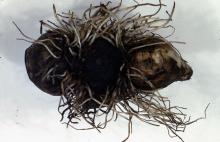Cause Pratylenchus penetrans and P. crenatus. P. penetrans is much more important because of its general distribution and wide host range. Root-lesion nematodes are migratory endoparasites; part of the population is in soil and part in roots at all times. Although not specially examined in the PNW, much of the damage is due to a fungus, Ilyonectria destructans, which gains entry into roots through lesion nematode feeding sites. The root rot has been called decline, replant disease and soil sickness in earlier literature.
Symptoms Prematurely yellow foliage and early-maturing plants in target-spot areas of a field usually indicate nematode damage. Infested areas may be difficult to find in an unusually wet season. Roots are greatly reduced; most show dark lesions or dead spots. If plants are severely infected, bulbs have no roots left. Because plants are damaged and mature early, bulb size is greatly reduced.
Sampling Samples sent for nematode analysis always should include soil and roots if plants are present. Take samples any time if the numbers are interpreted in relation to nematode population dynamics. In most crops, populations are relatively low through winter and spring but increase rapidly through summer. It is best to take samples in late summer to test for nematodes in fields that are going to be planted to daffodil.
Replicated studies have shown that damage may result if nematodes average 0.2 to 1 per 100g of soil. Local soil types, climate, moisture, and other factors vary widely where damage could occur at different nematode densities.
Cultural control
- Rotate 5 years out of bulbs and remove volunteer plants from previous bulb crops.
- Soak lightly infected stocks in properly designed equipment, when bulbs are fully dormant. Soak 4 hours in water at 110°F to 111°F soon after digging bulbs. The treatment can distort flowers and leaves and spreads basal rot disease from infected to healthy bulbs; therefore, do not treat basal-rot-infected stock with hot water.
Chemical control Preplant soil fumigation.
- Telone II. Rates depend on planting depth and soil type; see label for details. 5-day reentry. Restricted-use pesticide.
- Telone C-17. Rates depend on planting depth and soil type; see label for details. 5-day reentry. Restricted-use pesticide.
Reference Barker, K.R. and Olthof, T.H.A. 1976. Relationships between nematode population densities and crop responses. Annual Review of Phytopathology 14:327-353.


